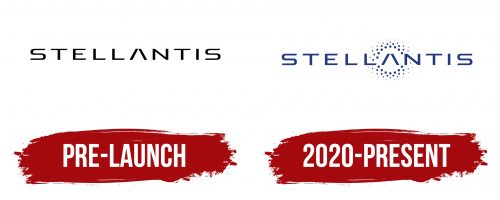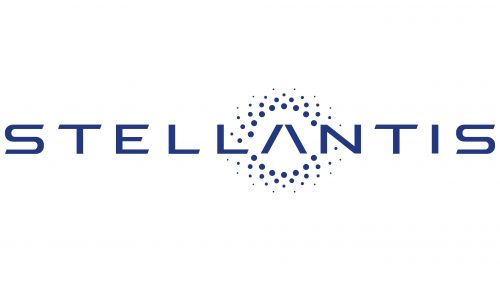The Stellantis logo appears simple and modest at first glance, but it encompasses an entire automotive world because the brand it represents covers a vast range of specialized work. The minimalist emblem perfectly reflects this practical approach to business.
Stellantis: Brand overview
Stellantis has a long history since the company was formally founded in 2021. Its roots are deeply ingrained in the automotive industry’s history, spanning more than a century of advancement and invention.
When Fiat Chrysler Automobiles (FCA) and PSA Group announced their intention to merge in October 2019, the first steps toward the development of Stellantis were initiated. The goal behind this choice was to establish a more formidable competitor for industry heavyweights like Toyota, Volkswagen, and General Motors.
With brands including Fiat, Chrysler, Jeep, Dodge, Ram, and Alfa Romeo, FCA, created in 2014 by the combination of America’s Chrysler and Italy’s Fiat, was already a formidable corporation. Conversely, the French automobile conglomerate PSA Group possessed Peugeot, Citroën, DS, Opel, and Vauxhall brands.
The merger procedure took over a year. During this time, the firms settled the terms of the agreement, secured the required regulatory clearances, and organized the future organizational structure of the combined business.
FCA and PSA concluded a legally binding agreement to unite on equal terms on December 18, 2019. This agreement was an important step toward the creation of Stellantis.
The shareholders approved the merger of both firms on January 4, 2021. This choice enabled the transaction to be completed and the new business formally established.
Officially, the firm was founded on January 16, 2021. The verb “stello,” which in Latin means “to shine with stars,” is the source of the firm name. The choice of this moniker represented the new automotive behemoth’s aspirations and potential.
Since its founding, the company has grown to be the fourth-biggest automaker globally by volume of sales. The fourteen car brands the business combined were Abarth, Alfa Romeo, Chrysler, Citroën, Dodge, DS, Fiat, Jeep, Lancia, Maserati, Opel, Peugeot, Ram, and Vauxhall.
John Elkann, the chairman of the FCA board, took on the position of chairman of the board of the newly formed firm, while Carlos Tavares, the former CEO of PSA Group, became the CEO of the new entity.
During the first few months of its founding, the firm concentrated on merging the two separate businesses. This includes uniting R&D centers, streamlining production procedures, and forging a cohesive corporate culture.
The company unveiled “Dare Forward 2030,” its inaugural strategy plan, in March 2021. This plan described the firm’s future over the following ten years and included aggressive targets for growing its market share internationally and creating cutting-edge technologies.
In 2021 and 2022, the enterprise kept refining its brand range and production capabilities. The corporation poured a lot of money into creating new platforms for electric cars to improve its standing in this quickly expanding sector.
2022 the organization announced several alliances and investments to strengthen its positions in important geographical and technological domains. This included collaborating with IT firms to create software and systems for self-driving cars.
In 2023, the manufacturer launched multiple new electric car models under different brands as part of its ongoing implementation of its strategic plan. Additionally, the firm sought to improve its standing in significant markets, including China and North America.
Over its brief but eventful history, the enterprise has shown that it can successfully blend the customs and cultures of many automakers by creating cutting-edge goods and services. The company keeps changing as it works to lead the automobile industry in technological advancements and sustainable mobility.
Meaning and History
What is Stellantis?
Fiat Chrysler Automobiles and PSA Group merged to create a global automotive giant featuring many well-known car brands. This international company’s remarkable lineup includes Jeep, Dodge, Ram, Fiat, Peugeot, Citroën, and Maserati. The brand develops advanced automotive technologies and designs, leveraging its extensive resources and combined expertise to meet the diverse needs of customers in various global markets. The organizational structure enables sharing platforms and technologies while preserving each brand’s heritage and identity. It competes across different types and price ranges of vehicles, from rugged SUVs and luxury sports cars to small, affordable cars.
2020 Pre – launche
The beta version of the Stellantis logo was so successful that it later became the basis for the official emblem. Its conciseness helped it hit the mark and capture the desired style. There is indeed nothing extraordinary or creative in the badge: it simply represents the name of the automotive corporation. But what a way it does! Its visual identity aligns with the latest branding trends.
A progressive font with extended contours was chosen for the text, perfectly fitting the concept of uniting independent, globally renowned manufacturers. The logo represents a group of companies brought together under the Stellantis banner. To emphasize their exclusivity, rich experience, professionalism, and success, the new structure received a “star” name, which was originally presented since “stella” translates from Latin as “star.”
- The first distinctive feature is the excessive width of the letters, making them appear flattened.
- The second creative aspect highlights the “S” ‘s similarity to a belt or a worm, as seen in NASA’s emblem.
- The third feature is the absence of a crossbar in the “A,” which makes it look like two domino pieces stacked in a “house” shape.
- The fourth characteristic showcases the uniqueness of the glyphs through angled cuts at the ends.
Together, they form a grand constellation of numerous bright stars. The spacing between the symbols is large enough to maintain each member’s individuality and properly display it within an equal setting.
The Stellantis emblem’s color palette is simple: it is mainly black because dark letters on a light background remain a timeless classic. A black font on a white background creates a businesslike atmosphere, demonstrates the corporation’s practicality, and underscores the rigor of its business principles.
2020 – today
The designers slightly adjusted the letters by keeping the original diagonal cuts. They refined them to be neater, more even, and tighter, though, at first glance, it seems like everything remains the same. However, now there are no narrow sections—all strokes have a uniform width. Previously, these variations were noticeable, especially in letters like “T,” “E,” and “L.” Additionally, the “S” no longer has a slight curve. All the glyphs now have the same boldness.
However, the Stellantis logo’s writing style remains unchanged: extravagant, elegant, and even slightly futuristic. The brand name is still low and wide, giving it a flattened appearance. The glyphs now feature another characteristic that’s not immediately noticeable due to the presence of graphic elements. The gap between the overlapping parallelograms in the “A” is larger than in the beta version. This change makes the letter more unique, giving it a symbolic peak: in the narrow area, the sides don’t touch each other and don’t form a sharp angle.
The company moved away from black and settled on a rich blue—a cold, fresh shade associated with professionalism, stability, and perfection. This color suits the brand’s visual identity better, as its name is linked to stars. The designers added a circular cluster of improvised “stars” to the emblem to emphasize the connection to the companies within the group.
Solid blue dots surround the central letter—a stylized “A.” They vary in diameter, making some bolder than others. The largest elements are closer to the glyph, while the smaller ones are further away. The alternating pattern creates an intriguing ornament that enhances the Stellantis logo. The pattern of numerous dots fits seamlessly into the brand’s concept, creating a relaxed atmosphere.






